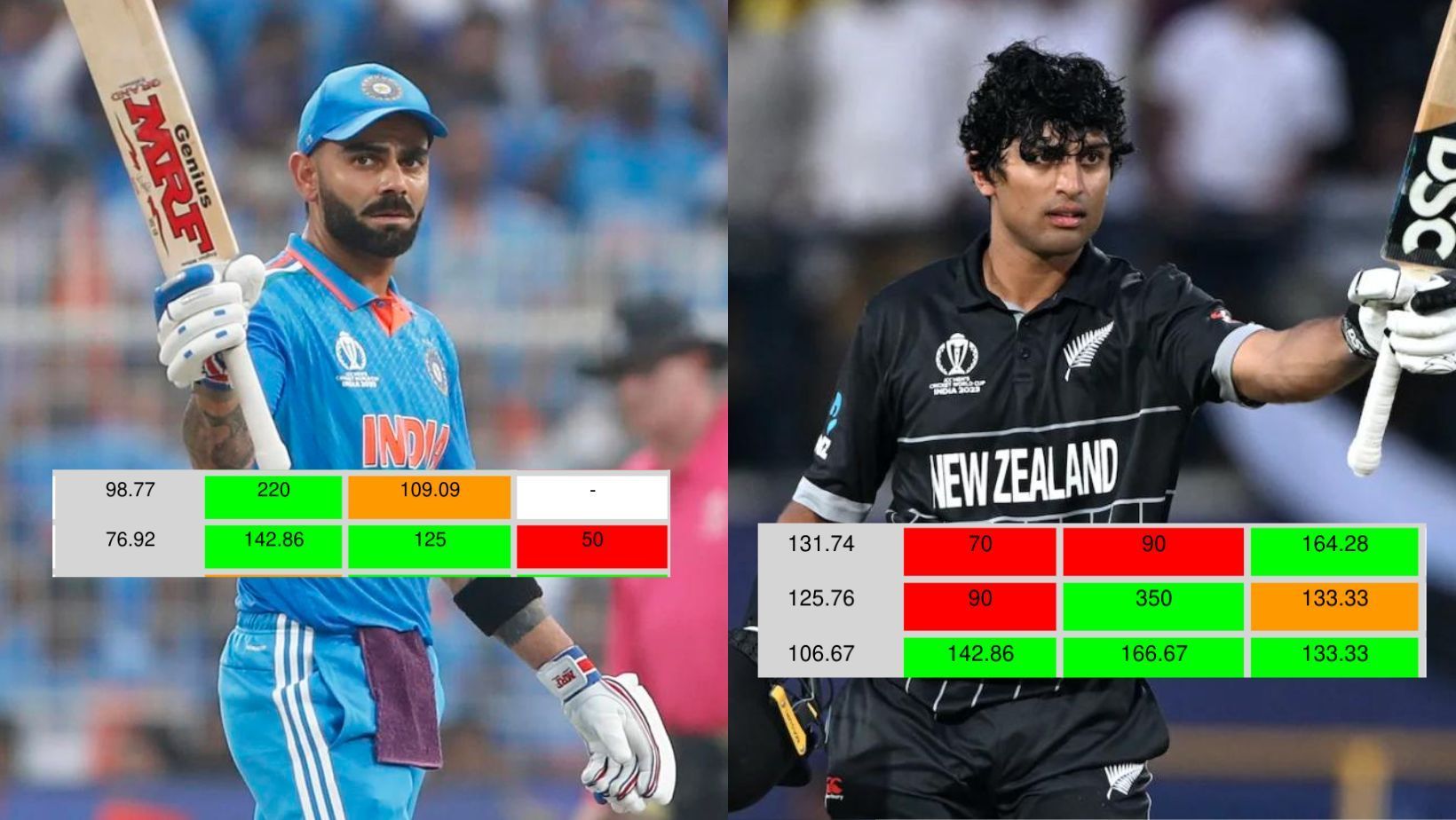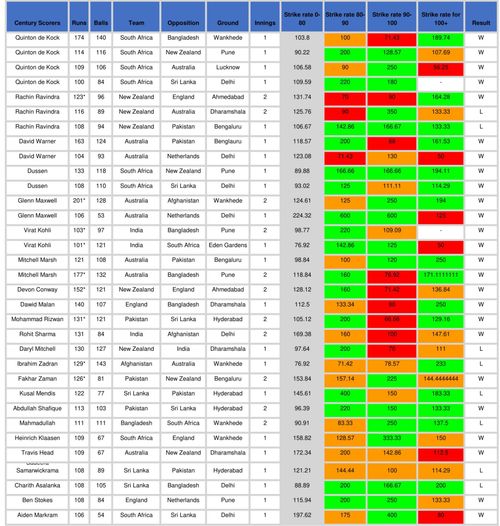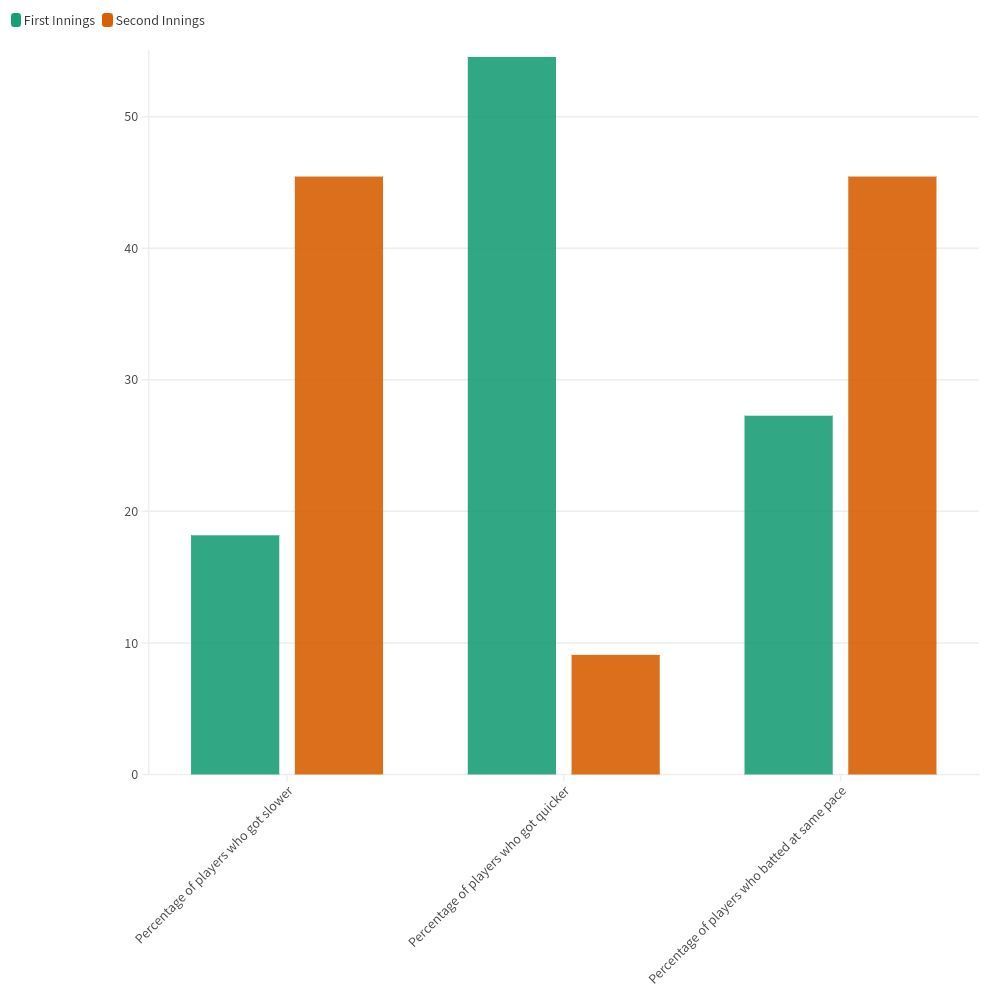
How many players slowed down before scoring a 100 in the 2023 World Cup?
There's a new trend among the observers of men's cricket. Whenever a player reaches 85-90, all eyes turn to his strike rate. Match situation, tournament situation, pitch conditions, and opposition tactics are all ignored for a few minutes and one question rages - is he slowing down to get to his 100?
Simon Doull is one factor behind it. The New Zealand pundit has often called out players, both his countrymen and otherwise, for reducing their strike rate when close to 100. He even generalized Indian players as obsessed with personal milestones, like a century, instead of taking risks for the team.
The other factor is Virat Kohli. India's No. 3 has been labeled "selfish" a few times in the 2023 World Cup. It happened against South Africa at the Eden Gardens when he dropped anchor in the death overs to let Ravindra Jadeja attack.
As it turned out, the pitch wasn't as attacking-friendly as some thought, and South Africa were bowled out for 83 in the second innings, 18 runs less than Kohli's 101.
Still, as he's close to breaking Sachin Tendulkar's record of 49 ODI tons, if he crosses the 90-run mark again against the Netherlands on Sunday and plays a dot ball, the cries of 'tuk-tuk' might return, maybe even louder than before.
Kohli has scored two centuries in the World Cup. Did he play 'tuk tuk' between 90-100 in either of those innings? Also, how right are Doull's observations - how many players in this World Cup indeed slowed down in the 'nervous 90s'?
Below, we've used cold, hard strike rate data to answer these questions for you.
Nine centurions slowed down between 90-100 runs

The 2023 World Cup has seen 33 centuries so far. Check the grey column in Table One. We have strike rates of all these centurions when they crossed the 80-run mark. The next three columns are their strike rates between crossing 80 to crossing 90, between crossing 90 to crossing 100, and the overall for post-100.
The strike rate from 0-80 is our base. Let's assume 'slowing down' to be a drop in the strike rate by 20 percent. If a batter's strike rate in the next three columns is less than 20 percent of our base, we give it a red color. If it's more than 20 percent of our base, we give it green (i.e. he scored quicker) and if it's within the 20 percent range we give it orange.
So there you have it - only three times in the 2023 World Cup, a batter slowed down after crossing 80. Rachin Ravindra did it twice and David Warner once. But on as many as nine occasions, batters slowed down between 90-100.
As expected, most batters started scoring at a quicker strike rate after crossing the three-figure mark. Among those who scored at least 110 runs, none slowed down after reaching their 100. Either they got quicker or maintained the same pace.
Some patterns stand out. Australia's Mitchell Marsh was guilty of slowing down between 90-100 in both of his tons. Interestingly, in both, he was striking at 160 between 80-90, but as soon as he crossed 90, the number dropped to 70s. The all-rounder picked up pace after going past his 100 on both occasions.
Other than that, there are two more centuries where the batter slowed down a lot between 90-100, despite having a great strike rate both before 90 and after 100. These are Warner's knock against Pakistan in Bengaluru and Mohammad Rizwan's against Sri Lanka in Hyderabad. The latter saw the most drastic drop.
The only knock with two reds in the 80-90 and 90-100 columns is of Ravindra's against England. It was the promising youngster's first World Cup match. He was batting at over 131 when he crossed 80 but slowed down massively until he reached his 100, before smashing it at 164.28 after crossing the milestone.
That 100 might have helped his nerves because he scored two more tons with strike rates of 350 and 166.67, respectively, between 90-100. His ton against Pakistan saw three greens - a constantly higher strike rate after crossing 80.
South Africa's Rassie van der Dussen (vs New Zealand in Pune), Pakistan's Abdullah Shafique (vs Sri Lanka in Hyderabad), and Sri Lanka's Charith Asalanka (vs Bangladesh in Delhi) were the others to achieve the feat.
Coming to Kohli, the only red mark in both of his tons is when he took two balls to score his last run against South Africa. Other than that, his strike rate only got better once he scored his 80 in both innings. A better strike rate usually means more risks. For the role Kohli has in the team, it looks like he has done enough.
Some batters' strike rates neither increase nor decrease much when they cross 80 and 90 respectively. Sri Lanka's Sadeera Samarwickrama's knock against Pakistan is one such example. Travis Head against New Zealand is another, with the Aussie batting at around 172 to reach his 80 and then remaining in the 20 percent range of it while crossing 90 and 100, respectively.
The two players with the best strike rate between 90-100 for their centuries should be obvious: Glenn Maxwell (600 against the Netherlands) and Aiden Markram (400 against Sri Lanka). Markram's was the fastest World Cup hundred before Maxwell broke the record a few days later. Both came at Delhi's Arun Jaitley Stadium.
Players slowed down more frequently in the second innings

If we see according to innings (see the graph above) more players tended to slow down between 90-100 during the second innings than in the first innings.
There's a simple explanation for this: among the five players who slowed down, four - Ravindra and Conway vs England, Marsh vs Bangladesh, and Rohit Sharma vs Afghanistan (or even Kohli for that matter) - did so when the match was more or less won. They could afford to take their time in the 90s and get the landmark.
First innings are more uncertain so players have more pressure to maintain or increase the pace of their knocks after crossing 80.
Four players still took a bit of luxury: Quinton de Kock vs Bangladesh, David Warner vs Pakistan, Dawid Malan vs England, and Daryl Mitchell vs India. All scored a green or an orange grade for their strike rates before crossing 90 and after reaching 100. This means they were particularly slow between 90-100.
Now, this brings us to our final question: how many players' slowing down in the 90s cost their team a win? Almost all of the red marks came in wins.
Only one between 90-100 came in a loss: Mitchell's 130 (127) against India in Dharamshala. He was 93 (90) and took nine balls to get to his 100, with his strike rate plummeting from 200 in the 80s to just 70 between 90-100.
It wasn't a coincidence that Doull was the first to call it out. The former international cricketer said he'd been fine if Mitchell had done this in the second innings but in the first, his "dawdling" in the 90s cost New Zealand some crucial runs.
“[People might say] ‘He got 130, what are you on about?’” Doull said. “It’s not about what he ended up on, it’s the balls that were used up during that time that perhaps he could have been more aggressive. He was seeing it well, one of the few that has played beautifully and it’s still a terrific innings, it’s just that time that you might look back on. And they’re small margins when you’re playing top quality teams, small margins.”
(The data was collected before the India-Netherlands match on November 12).